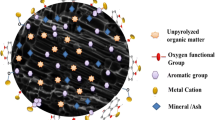Abstract
Date palm seed being one of the major waste biomass produced in UAE, is assessed for its potential to be an appropriate precursor for preparation of porous carbon by utilizing KOH as an activating agent through application of process optimization. Process optimization was performed using the popular response surface methodology adopting a Box–Behnken design, to maximize porous carbon BET surface area and % yield, by altering activation temperature, activation time and impregnation ratio. The chemical reactions involved during the impregnation and the carbonization processes for these hydroxide/lignocellulose mixtures present in date palm seed have been proposed. A deep insight has been obtained concerning the possible reactions mechanism. The adsorption capacity was estimated using Iodine adsorption, which infers micropore nature of the porous carbon and it can be utilized for an effective waste water treatment with smaller molecular size substrates.








Similar content being viewed by others
References
Adinata D, Daud WMWA, Aroua MK (2007) Preparation and characterization of activated carbon from palm shell by chemical activation with K2CO3. Bioresour Technol 98(1):145–149
Baquero MC, Giraldo L, Moreno JC, Suraz-Garcia F, Martinez-Alonso A, Tascon JMD (2003) Activated carbons by pyrolysis of coffee bean husks in presence of phosphoric acid. J Anal Appl Pyrol 70(2):779–784
El-Hendawy AA (2009) An insight into the KOH activation mechanism through the production of microporous activated carbon for the removal of Pb2+ cations. Appl Surf Sci 255(6):3723–3730
El-Naas MH, Al-Zuhair S, Abu Alhaija M (2010) Reduction of COD in refinery wastewater through adsorption on date-pit activated carbon. J Hazardous Mater 173(1–3):750–757
Gonen F, Aksu Z (2008) Use of response surface methodology (RSM) in the evaluation of growth and copper (II) bioaccumulation properties of candida utilis in molasses medium. J Hazardous Mater 154(1–3):731–738
Guo J, Luo Y, Chong Lua A, Chi R, Chen Y, Bao X, Xiang S (2007) Adsorption of hydrogen sulphide (H2S) by activated carbons derived from oil-palm shell. Carbon 45(2):330–336
Hameed BH, Tan IAW, Ahmed AL (2008) Optimization of basic dye removal by oil palm fiber-based activated carbon using response surface methodology. J Hazardous Mater 158(2–3):324–332
Hameed BH, Salman JM, Ahmad AL (2009) Adsorption isotherm and kinetic modeling of 2, 4-D pesticide on activated carbon derived from date stones. J Hazardous Mater 163(1):121–126
Hebeish A, Ramadan MA, Abdel-Halim E, Abo-Okeil A (2011) An effective adsorbent based on sawdust for removal of direct dye from aqueous solutions. Clean Technol Environ Policy 13(5):713–718
Kashif R, Suresh Kumar reddy K, Shoaibi AA, Srinivasakannan C (2013) Sulfur-impregnated porous carbon for removal of mercuric chloride: optimization using RSM. Clean Technol Environ Policy 15(6):1041–1048
Lyubchik SB, Benoit R, Beguin F (2002) Influence of chemical modifications of anthracite on the porosity of the resulting activated carbons. Carbon 40(8):1287–1294
Prahas D, Kartika Y, Indraswati N, Ismadji S (2008) Activated carbon from jackfruit peel waste by H3PO4 chemical activation: pore structure and surface chemistry characterization. Chem Eng J 140(1–3):32–42
Rashidi NA, Yusup S, Borhan A, Loong LH (2014) Experimental and modeling studies of carbon dioxide adsorption by porous biomass derived activated carbon. Clean Technol Environ Policy 16(7):1353–1361
Salam JM, Njoku VO, Hameed BH (2011) Bentazon and carbofuran adsorption onto date seed activated carbon: kinetics and equilibrium. Chem Eng J 173(2):361–368
Sentorun-shalaby C, Ucak-Astalioglu MG, Artok L, Sarici C (2006) Preparation and characterization of activated carbons by one step steam pyrolysis/activation from apricot stones. Microporous Mesoporous Mater 88:126–134
Sudaryanto Y, Hartono SB, Irawaty W, Hindarso H, Ismadji S (2006) High surface area activated carbon prepared from cassava peel by chemical activation. Bioresour Technol 97(5):734–739
Suresh Kumar Reddy K, Shoaibi AA, Srinivasakannan C (2012a) A comparison of microstructure and adsorption characteristics of activated carbons by CO2 and H3PO4 activation from date palm pits. New Carbon Mater 27(5):344–351
Suresh Kumar Reddy K, Shoaibi AA, Srinivasakannan C (2012b) Activated carbon from date palm seed: process optimization using response surface methodology. Waste Biomass Valor 3:149–156
Tan IAW, Hameed BH, Ahmad AL (2008) Optimization of preparation conditions for activated carbons from coconut husk using response surface methodology. Chem Eng J 137(3):462–470
Wang J, Kaskel S (2012) KOH activation of carbon-based materials for energy storage. J Mater Chem 22:23710–23725
Wang H, Gao Q, Hu J (2009) High hydrogen storage capacity of porous carbons prepared by using activated carbon. J Am Chem Soc 131(20):7016–7022
Yang T, Lua AC (2003) Characteristics of activated carbons prepared from pistachio-nut shells by physical activation. J Colloid Interface Sci 267(2):408–417
Zhao W, Fierro V, Zlotea C, Aylon E, Izquierdo MT, Latroche M, Celzard A (2011) Optimization of activated carbon for hydrogen storage. Int J Hydrogen Energ 36(18):11746–11751
Zhao W, Fierro V, Zlotea C, Aylon E, Izquierdo MT, Latroche M, Celzard A (2012) Impact of synthesis conditions of KOH activated carbons on their hydrogen storage capacities. Int J Hydrogen Energy 37(19):14278–14284
Acknowledgments
The authors wish to acknowledge the financial support from the petroleum Institute for giving an opportunity to work on Porous carbon development (RIFP-14316/2014).
Author information
Authors and Affiliations
Corresponding author
Rights and permissions
About this article
Cite this article
Suresh Kumar Reddy, K., Shoaibi, A.A. & Srinivasakannan, C. Impact of process conditions on preparation of porous carbon from date palm seeds by KOH activation. Clean Techn Environ Policy 17, 1671–1679 (2015). https://doi.org/10.1007/s10098-014-0875-8
Received:
Accepted:
Published:
Issue Date:
DOI: https://doi.org/10.1007/s10098-014-0875-8




